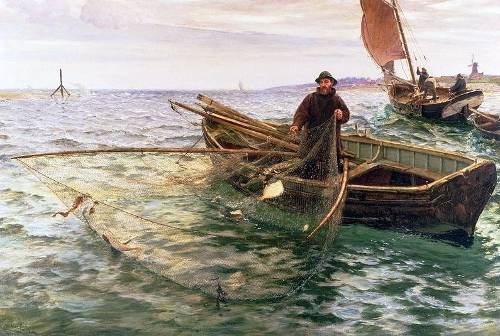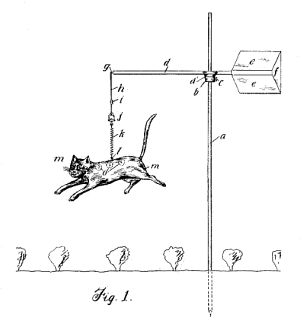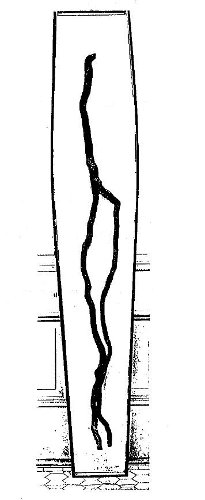
piscation
n. fishing
halieutics
n. a treatise on fish or the art of fishing

piscation
n. fishing
halieutics
n. a treatise on fish or the art of fishing
Choose any number and write down its divisors:
14
1 2 7 14
Then write down the number of divisors of each of these divisors:
14
1 2 7 14
1 2 2 4
Now the square of the sum of this last group will always equal the sum of its members’ cubes:
(1 + 2 + 2 + 4)2 = 13 + 23 + 23 + 43
Discovered by Joseph Liouville.

In 1916, inventor Hugh Huffman offered “a more efficient form of scarecrow,” a faux cat mounted on a wind vane and fitted with bells. “The action of the wind will give various motions to the figure which will simulate the lifelike movements of the animal.”
If it worked then, it ought to work now.
Two very old stories are worth repeating for their peculiar excellence. A Scotch newspaper, reporting the danger that an express-train had run in consequence of a cow going upon the line, said, ‘As the safest way, the engineer put on full steam, dashed up against the cow, and literally cut her into calves.’ In the earlier half of this century a London paper announced that Sir Robert Peel and a party of fiends were shooting peasants in Ireland.
— William Shepard Walsh, Handy-Book of Literary Curiosities, 1892

On July 21, 1759, Emanuel Swedenborg attended a dinner party after returning to Gothenburg from England. He went out for a short interval and returned pale and agitated. He told the party that a fire had broken out in Stockholm, 250 miles away, and that it was spreading quickly. He said it had already destroyed the house of one of his friends, whom he named, and that his own house was in danger. Two hours later he exclaimed, “Thank God! The fire is extinguished the third door from my house.”
The following morning the governor questioned Swedenborg, who provided a description of the fire, including how it had begun and ended, and word spread throughout the city. Two days later a messenger arrived from Stockholm bearing letters that confirmed Swedenborg’s account, and a royal courier brought news reporting the extent of the fire, the houses it had damaged and destroyed, and the time it was put out. All confirmed Swedenborg’s description.
“What can be brought forward against the authenticity of this occurrence?” wrote Immanuel Kant, who elsewhere criticized Swedenborg’s mysticism. “My friend who wrote this to me, has not only examined the circumstances of this extraordinary case at Stockholm, but also, about two months ago, at Gottenburg, where he is acquainted with the most respectable houses, and where he could obtain the most authentic and complete information, as the greatest part of the inhabitants, who are still alive, were witnesses to the memorable occurrence.”
In the days before chess clocks, a player might wait for hours while his opponent decided on a move.
Morphy’s companion Frederick Milnes Edge remarked that “[József] Szén was so frightfully slow, even in ordinary games, that he would have worn out 200 francs’ worth of his opponent’s pantaloons before the match was half through.”
The most notorious slowpoke in England was Elijah “The Bristol Sloth” Williams: In the fourth game of his London match against Henry Thomas Buckle in 1851, Williams lavished such exquisite care on his 25th move that Buckle had time to write two chapters of his History of Civilization.
Buckle won. “The slowness of genius is hard to bear,” he said, “but the slowness of mediocrity is intolerable.”

Do holes exist? That is, if a hole is merely a void or vacancy in a surrounding substance, then properly speaking is the hole a thing in itself? Philosopher Roberto Casati writes, “Ask any person to tell you what holes are — ‘real,’ everyday holes, not the abstract holes of geometry – and he will likely elaborate upon absences, nonentities, nothingnesses, things that are not there. Are there such things?”
A hole story from John Timbs’ 1873 A Century of Anecdote:
A gentleman, one Sunday morning, was attracted to watch a young country girl on the high road from the village to the church, by observing that she looked hither and thither, this way and that upon the road, as if she had lost her thimble. The bells were settling for prayers, and there was no one visible on the road except the girl and the gentleman, who recognised in her the errand-maid of a neighbouring farmer. ‘What are you looking for, my girl?’ asked the gentleman, as the damsel continued to pore along the dusty road. She answered, gravely: ‘Sir, I’m looking to see if my master be gone to church.’ Now, her master had a wooden leg.
In number theory, a Holey prime is a prime number made up exclusively of the digits 4, 6, 8, 9, and 0 — digits whose Arabic numerals contain “holes.” Ironically, these get pretty substantial: The largest known specimen is a 4 followed by 16,131 9s.
“There is no such thing on earth as an uninteresting subject; the only thing that can exist is an uninterested person.”
— G.K. Chesterton

It has been recorded by reliable authority that near the graves of Roger Williams, the founder of Rhode Island, and his wife, there stood a venerable apple-tree which had sent two of its roots into the graves of Mr. and Mrs. Williams. The larger root had pushed its way through the earth till it reached the precise spot occupied by the skull of Roger Williams. There, making a turn, as if going round the skull, it followed the direction of the backbone to the hips. Here it divided into two branches, sending one of them along each leg to the heel, where both turned upward to the toes. One of these roots formed a slight crook at the knee, which made the whole bear close resemblance to a human form. There were the graves, emptied of every particle of human dust. Not a trace of any thing was left. There stood the guilty ‘apple-tree,’ as it was said at the time, caught in the very act of ‘robbing the grave.’ The fact proved conclusively that bones, even of human beings, are an excellent fertilizer for fruit-trees; and the fact must be admitted that the organic matter of Roger Williams had been transmitted into the apple-tree; it had passed into the woody fibre, and was capable of propelling a steam-engine; it had bloomed in the apple-blossoms, and had become pleasant to the eye; and more, it had gone into the fruit from year to year, so that the question might be asked, Who ate Roger Williams?
— Sereno Edwards Todd, The Apple Culturist, 1871